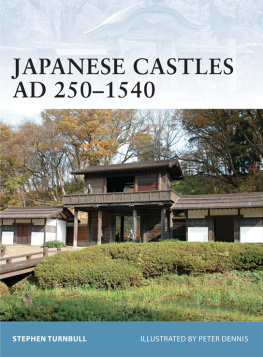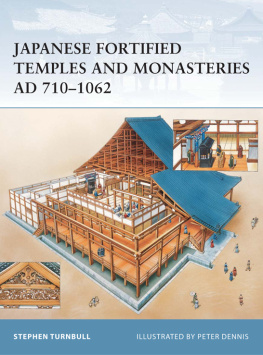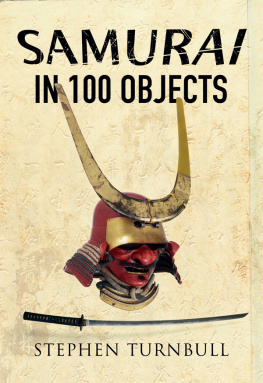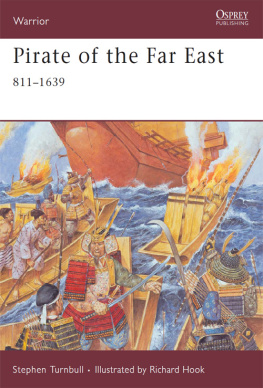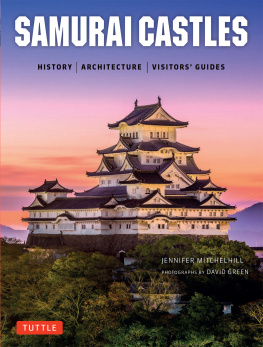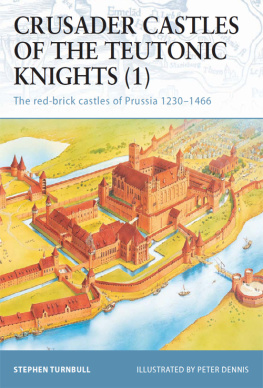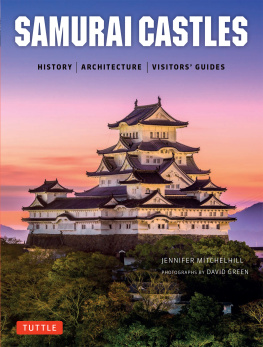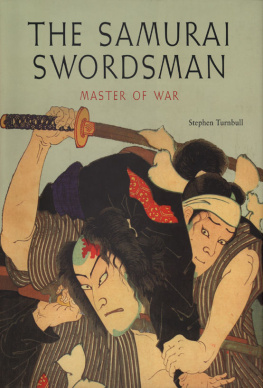FORTRESS 74
JAPANESE CASTLES AD 2501540
| STEPHEN TURNBULL | ILLUSTRATED BY PETER DENNIS |
| Series editors Marcus Cowper and Nikolai Bogdanovic |
CONTENTS






JAPANESE CASTLES AD 2971540
INTRODUCTION
The first Japanese fortifications
The earliest known use of fortified sites in Japan dates from the Yayoi Period (c.300 BC AD 300), which succeeded the Neolithic Jmon Period (c.10,000300 BC ). Jmon culture had been characterized by hunter/gatherer behaviour followed by primitive agriculture. Until quite recently, it was assumed that Jmon communities consisted of no more than a dozen or so households, but excavation of the archaeological site of Sannai-Maruyama in Aomori Prefecture has revealed a large village containing what may have been a fortified structure. Six 1m-wide postholes were found, each of which formerly held a massive pillar of chestnut wood. This may indicate the presence of a lookout tower, which would imply defensive purposes, or it may even be a religious structure.
Unless further archaeological work is able to identify Sannai-Maruyama unequivocally as a fortified site, the introduction of fortifications to Japan must be dated to the succeeding Yayoi Period. The most important innovation associated with the Yayoi culture was the introduction of wet-rice cultivation by immigrants from the Asian continent. This resulted in the rapid development of food production and a consequent increase in population. The immigrants also introduced metals into the Japanese archipelago first iron and then bronze the reverse of the order found in other parts of the world. Iron was used primarily for tools, while bronze was cast into weapons and bells. Skeletal remains show that the people who brought the Yayoi culture were taller than the natives they displaced.
There is a wealth of archaeological evidence to suggest that warfare and fortifications played a part in the expansion of the Yayoi settlements. The discovery of broken tips of stone or bronze weapons lodged in the bones of Yayoi Period skeletons from the 2nd and 3rd centuries AD has been interpreted as indicating the onset of war and some of its likely victims. The frequency of weapon finds among bodies in the Yayoi Period is particularly striking when compared to burials in the Jmon Period. Out of the 5,000 skeletons excavated from Jmon graves since 1947, only ten appear to have suffered violent deaths, yet among the 1,000 skeletons associated with Yayoi sites, 100 appear to have died as a result of wounds inflicted by weapons. One victim at Doigahama appears to have been killed when a stone arrowhead struck his skull. A female skeleton in Nejiko in Nagasaki Prefecture has a bronze arrowhead lodged in her skull, while several skeletons at Yoshinogari in Kysh are headless.
The development of warfare at this time has been explained as follows. As populations grew and more land was sought neighbours may well have fought each other over scarce lands and reliable sources of water. We know that settlements were extended into the upper reaches of river valleys as well as the lower-lying areas, and it is at this time that we first come across evidence that some, but by no means all communities sought to protect their interests by the creation of fortifications. The first phase of defensive considerations appears to have been simply the establishment of settlements located on high ground, because numerous Yayoi Period hamlets containing between three and five households have been identified some 200 or 300m above sea level. These highland settlements (kchisei shraku) could of course merely have been bases from which the fertile lower ground could be cultivated without wasting any valuable space. This may well have been the original reason for their creation during the 1st century AD , but the discovery of weapons at some later sites, together with scorched earth and ashes (which may indicate the sites of beacons) has suggested an additional military role. Indeed, it is now accepted that most upland sites at least provided the function of a lookout post in case of an attack.
This archaeological evidence for fortification and sporadic conflict is reflected in the earliest written accounts concerning Japan. These may be found in the Chinese dynastic histories, of which the first to refer to Japan is the Wei Zhi, the history of the Wei dynasty ( AD 22065), which was compiled about AD 297. The account of the country of Wa, as Japan was then known, appears in a section in which Chinas barbarian neighbours are described, and, although the description is brief, it includes the mention of a fortified place:
The country formerly had a man as ruler. For some 70 or 80 years after that there were disturbances and warfare. Thereupon the people agreed upon a woman for their ruler. Her name was Himiko. She occupied herself with magic and sorcery, bewitching the people. She resided in a palace surrounded by towers and stockades, with armed guards in a state of constant vigilance.
A very similar description occurs in the Hou Hanshu, the history of the Later Han dynasty, compiled in about AD 445. The suggestion by the author of the Wei Zhi that warfare developed in Japan in the 2nd and 3rd centuries AD tallies with the archaeological evidence noted above, which also shows that this was a time when arrowheads were being produced that were heavier and deadlier than those made for hunting. The spacing of the highland settlements allowed smoke signals to be sent from one base to another, and these hamlets frequently lay within a short distance of major Yayoi settlements.
Yoshinogari is the most important Yayoi Period site in Japan. It possesses several defensive features, most of which are shown in this view looking in towards the main enclosure. There are three watchtowers, a palisade fence and a ditch. A simple tower protects the gateway. In the foreground is a rice storehouse.
These larger Yayoi sites have been well studied, and provide strong evidence of early Japanese fortifications. Important places such as Otsuka near Yokohama and Yoshinogari in Kysh were settlements protected by ditches (kang shurak). Ditches have also been found in certain highland sites, and half a century of excavation has revealed 79 such villages from Kysh to northern Honsh. Asahi in Aichi Prefecture provides a good example of a fortified Yayoi village. Three ditches provided defence. The outer one was between 5 and 7m wide and 1.5m deep; while the inner two were between 1.5 and 2m deep. Inside the ditches stakes, planks of wood and twisted branches had been arranged to make access impossible except across the bridges the linked the various sections. Beyond the outer ditch was a thigh-high line of stakes and planking. All such sites are of the Yayoi Period, and none is later than AD 300.
Next page
